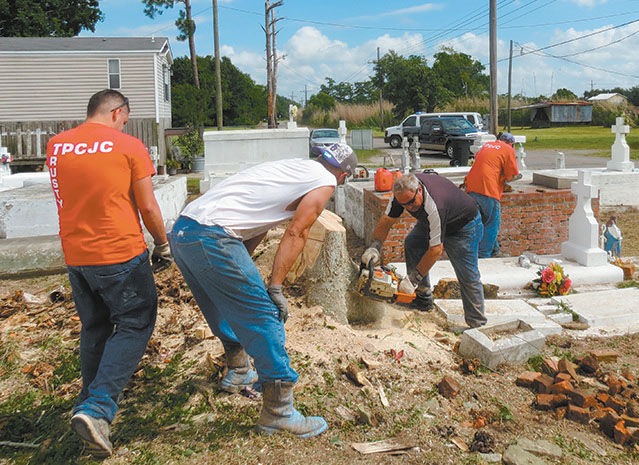
‘There she is…’ Queen Courtney Salas to reign at 2015 Rougarou Festival
May 6, 2015
SULPHUR-BOUND!
May 13, 2015With rakes and shovels, dirt-movers and a chainsaw, Terrebonne Parish jail inmates and their keepers cleared a felled tree, weeds, branches and other debris from a Dulac cemetery last week.
For survivors and descendants of people whose final resting place is Prevost Cemetery on Shrimper’s Row, the heavy labor performed by the inmates is a gift for which thanks are not enough.
The troubled cemetery is only one of many in Terrebonne, Lafourche and other coastal parishes orphaned, neglected, or in some cases slipping into the sea as the Gulf of Mexico continues gnawing at Louisiana’s land with non-failing teeth of salt.
Prevost, where some crypts were dislodged by Hurricane Rita in 2005 but retrieved, also with Sheriff’s Office assistance, would appear ideal as a site for inmate labor.
But the cemetery is privately owned, by a family that has neither the interest nor the ability to keep it up on a routine basis.
Sheriff Jerry Larpenter, who personally ordered the cemetery work, says use of the inmates – whose labor is by law considered a public asset – on a privately owned patch of land is entirely
justifiable.
“Look at the shape these graves are in,” Larpenter said while personally reviewing work performed under a bright morning sun, by a crew of about a dozen red-shirted inmates. “We had a lot of work to do here after Rita. We’re hoping we don’t have to again.”
As Larpenter observed a team of inmates clearing a grave flush with the ground of so much brush and branches that its very presence had been hidden, Col. Tommy Odom with the help of his charges sawed through a the trunk of a massive tree that had fallen on several graves, dislodging a statue of the Virgin Mary and adding to the ramshackle, overgrown and stormtossed appearance.
The cemetery land is owned by the estate of Paul Scott, and is adjacent to a lot on which sits a mobile home. One of Scott’s descendants, Carletta Dunne, said she is grateful the Sheriff chose to help out.
She and other relatives have for years sought to give the cemetery away, and are waiting for a final answer from the Grand Caillou-Dulac Band of the Biloxi-Chitimacha people.
Tribal Chief Shirell Parfait-Dardar said that while desire exists, details still need to be worked out.
“It is a good thing, it is very sweet of the sheriff to do that,” she said. “The cemetery is in such disrepair, it has been so neglected. We are hoping they haven’t accidentally damaged some graves that are flat to the ground.”
She said she understands how the family claiming ownership might have difficulty with upkeep.
“They inherited burial grounds and they are not in the burial business,” she said.
There are concerns, Parfait-Dardar said, about whether the title to the cemetery is clear as it stands.
The tribe has appointed local forensic consultant Lucretia McBride, a former Terrebonne Parish Cemetery administrator, as its agent for purposes of working out details on the cemetery. Parfait-Dardar and McBride have opened a Facebook page called Friends of Prevost Cemetery which they hope will raise awareness of the cemetery’s plight, and draw the interest of further descendants of its dead.
“This is very important to us,” Parfait-Dardar said. “Our people are resting there. My father is there. All of my grandparents are there, my baby brother, my aunts and uncles. My father is in the front row.”
Former United Houma Nation Chief Kirby Verret said his grandmother, Lucy Parfait Dardar, who died at the age of 107, is buried in the cemetery along with other relatives.
McBride said she contacted Larpenter to discuss matters about the cemetery’s condition, although she did not expect that full crews would actually be dispatched.
“I just had some questions and wanted to talk with him,” McBride said. “We have got a cemetery that is not legal, private property being used as a public cemetery when it is not public I had concerns because the cemetery is located on private property.”
The attorney for the Sheriff’s Office, Bill Dodd, said he discussed the matter with Larpenter who wanted to take action as soon as possible.
“This is the same cemetery they repaired in 2005 after Hurricane Rita,” Dodd said. “At that time they tried to locate whoever owned the facility. No one has ever been able to determine who owns this. Unless the stuff was cleaned out down there to assist in drainage and weed growth and the other problems there was going to be a serious health issue. Something had to be cleared out. We did not want to see a recurrence of this because of all the growth loosening tombs. It is important for people who have relatives buried in there, but more it becomes a health issue in terms of what could happen. That is why Jerry took the bull by the horns. We are getting ready to begin hurricane season.”
Parish Councilman Daniel Babin – now an announced candidate for parish president – was among public officials who praised Larpenter’s decision.
“The sheriff in this parish continues to do what he can do with the inmate population to make this parish a better place,” said Babin, in whose district the cemetery lies. “There was a need and they serviced the need. I can’t speak highly enough about the sheriff and I called to thank him for the job they did.”
Jessica H. Schexnayder, who works for Louisiana SeaGrant at Louisiana State University, has included some Terrebonne and Lafourche cemeteries in an on-going independent study of Louisiana’s burial grounds as part of a budding restoration project. The problem of cemeteries that go without care, she said, is on the increase in Louisiana’s coastal parishes.
“One of the main problems we have is that people are being forced inland in response to storms, the erosion of our coastal lands, multiple reasons, even subsidence, sea level rise,” she said. “As people move further and further inland they are not going back to take care of those cemeteries they often become abandoned or overlooked. Eventually the cemeteries will surrender because there is no plan to save these cultural icons.”
Terrebonne Parish jail inmates work to clear a debris-littered Prevost Cemetery on Shrimper’s Row in Dulac, as Col. Tommy Odom (crouching at right) cuts a tree limb with a chain saw Thursday.








